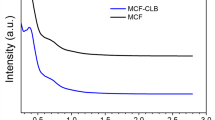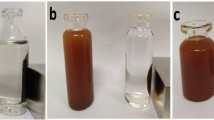Abstract
The study investigates curcumin/SPIONs hybridized mesocellular foam type silica for potential dual purpose of drug delivery (curcumin) and magnetic resonance imaging. Magnetization capability and curcumin release was assessed for different structured silica such as spherical silica (Q-10), Si-MCM-41, Si-SBA-16, mesocellular foam (MSU-Foam), Si-KIT-6, ULPFDU-12, and silicalite. The phase, textural, and morphological variation was systematically scrutinized using various physico-chemical techniques. Ten weight percent SPIONs loading was found to generate magnetically active SPIONs in the following order: Q-10 (1.44 emu/g) > SBA-16 (0.80 emu/g) > MSU-Foam (0.24 emu/g) > Si-MCM-41 (0.07 emu/g) > Si-KIT-6 (0.07 emu/g) > silicalite (0.08 emu/g), respectively. The iron oxide dispersion, specific surface area, and porosity play a major role in various structured silicas. MSU-Foam with wormhole structure showed highest specific surface area occupation of SPIONs (73%). The presence of interconnected porosity of foam tends to generate external agglomeration of SPIONs (7–18 nm) at the pore surface contributing to expansion of pore sizes from 16.4 to 40.2 nm. The SPIONs over spherical micron-sized silica Q-10 showed the formation of large nanoclusters (10–25 nm). Thirty to 390 μg/ml of curcumin was loaded over silica and SPIONs/silica structured hybrid, and drug release was studied at pH 5.6 for 72 h. SPIONs/MSU-Foam with less magnetization showed the highest cumulative curcumin release (53.2%), while Q-10 spherical silica with high magnetization property showed less cumulative release of curcumin (12%).










Similar content being viewed by others
References
Cole, J.T., Holland, N.B.: Multifunctional nanoparticles for use in theranostic applications. Drug Deliv. Transl. Res. 5, 295–309 (2015)
Ravinayagam, V., Jermy, R.B.: Studying the loading effect of acidic type antioxidant on amorphous silica nanoparticle carriers. J. Nanopart. Res. 19, 190 (2017)
Mulik, R.S., Monkkonen, J., Juvonen, R.O., Mahadik, K.R., Paradkar, A.R.: Transferrin mediated solid lipid nanoparticles containing curcumin: enhanced in vitro anticancer activity by induction of apoptosis. Int. J. Pharm. 398, 190–203 (2010)
Jambhrunkar, S., Karmakar, S., Popat, A., Yu, M., Yu, C.: Mesoporous silica nanoparticles enhance thecytotoxicity of curcumin. RSC Adv. 4, 709–712 (2014)
He, Q., Shi, J., Chen, F., Zhu, M., Zhang, L.: An anticancer drug delivery system based on surfactant-templated mesoporous silica nanoparticles. Biomaterials. 31, 3335–3346 (2010)
Slowing, I.I., Vivero-Escoto, J.L., Wu, C.W., Lin, V.S.: Mesoporous silica nanoparticles as controlled release drug delivery and gene transfection carriers. Adv. Drug Deliv. Rev. 60, 1278–1288 (2008)
Kwon, S., Singh, R.K., Perez, P.A., Abou Neel, E.A., Kim, H.W., Chrzanowski, W.: Silica-based mesoporous nanoparticles for controlled drug delivery. J. Tissue Eng. 4, 2041731413503357 (2013)
Baek, J.-S., Cho, C.-W.: Surface modification of solid lipid nanoparticles for oral delivery of curcumin: improvement of bioavailability through enhanced cellular uptake, and lymphatic uptake. Eur. J. Pharm. Biopharm. 117, 132–140 (2017)
Mutalik, S., Suthara, N.A., Managuli, R.S., Shetty, P.K., Avadhani, K., Kalthur, G., Kulkarni, R.V., Thomas, R.: Development and performance evaluation of novel nanoparticles of agrafted copolymer loaded with curcumin. Int. J. Biol. Macromol. 86, 709–720 (2016)
Howell, M., Wang, C., Mahmoud, A., Hellermann, G., Mohapatra, S.S., Mohapatra, S.: Dual-function theranostic nanoparticles for drug delivery and medical imaging contrast: perspectives and challenges for use in lung diseases. Drug Deliv. Transl. Res. 3, 352–363 (2013)
Estelrich, J., Escribano, E., Queralt, J., Busquets, M.A.: Iron oxide nanoparticles for magnetically-guided and magnetically-responsive drug delivery. Int. J. Mol. Sci. 16, 8070–8101 (2015)
Almeida, E.A.M.S., Bellettini, I.C., Garcia, F.P., Farinácio, M.T., Nakamura, C.V., Rubira, A.F., Martins, A.F., Muniz, E.C.: Curcumin-loaded dual pH- and thermo-responsive magnetic microcarriers based on pectin maleate for drug delivery. Carbohydr. Polym. 171, 259–266 (2017)
Huang, S., Li, C., Cheng, Z., Fan, Y., Yang, P., Zhang, C., Yang, K., Lin, J.: Magnetic Fe3O4@mesoporous silica composites for drug delivery and bioadsorption. J. Colloid Interface Sci. 376, 312–321 (2012)
Tian, Z., Yu, X., Ruan, Z., Zhu, M., Zhu, Y., Hanagata, N.: Magnetic mesoporous silica nanoparticles coated with thermo-responsive copolymer for potential chemo- and magnetic hyperthermia therapy. Microporous Mesoporous Mater. 256, 1–9 (2018)
Yiu, H.H.P., Niu, H.J., Biermans, E., vanTendeloo, G., Rosseinsky, M.J.: Designed multifunctional nanocomposites for biomedical applications. Adv. Funct. Mater. 20, 1–11 (2010)
Lachowicz, D., Szpak, A., Zietekc, K.E.M., Kepczynski, M., Mullerd, R.N., Laurent, S., Nowakowska, M., Zapotoczny, S.: Biocompatible and fluorescent superparamagnetic iron oxide nanoparticles with superior magnetic properties coated with charged polysaccharide derivatives. Colloids Surf. B: Biointerfaces. 150, 402–407 (2017)
Wang, F., Hui, H., Barnes, T., Barnett, C., Prestidge, C.: Oxidized mesoporous silicon microparticles for improved oral delivery of poorly soluble drugs. Mol. Pharm. 7, 227–236 (2009)
Hu, Y., Zhi, Z., Zhao, Q., Wu, C., Zhao, P., Jiang, H., Jiang, T., Wang, S.: 3D cubic mesoporous silica microsphere as a carrier for poorly soluble drug carvedilol. Microporous Mesoporous Mater. 147, 94–101 (2012)
Schmidt, W.P., Glinka, C.J., Stucky, G.D.: Microemulsion templates for mesoporous silica. Langmuir. 16, 356–361 (2000)
Cuello, N.I., Elías, V.R., Mendieta, S.N., Longhi, M., Crivello, M.E., Oliva, M.I., Eimer, G.A.: Drug release profiles of modified MCM-41 with superparamagnetic behavior correlated with the employed synthesis method. Mater. Sci. Eng. C. 78, 674–681 (2017)
Wang, Y., Zhang, Q., Shishido, T., Takehira, K.: Characterizations of iron-containing MCM-41 and its catalytic properties in epoxidation of styrene with hydrogen peroxide. J. Catal. 209, 186–196 (2002)
Cuello, N., Elias, V., Urreta, S., Oliva, M., Eimer, G.: Microstructure and magnetic properties of iron modified mesoporous silica obtained by one step direct synthesis. Mater. Res. Bull. 48, 3559–3563 (2013)
Lu, Y., Zheng, J., Liu, J., Mu, J.: Fe-containing mesoporous silicates with macro-lamellar morphology. Microporous. Mesoporous Mater. 106, 28–34 (2007)
Bhandari, R., Gupta, P., Dziubla, T., Zach, H.J.: Single step synthesis, characterization and applications of curcumin functionalized iron oxide magnetic nanoparticles. Mater. Sci. Eng. C. 67, 59–64 (2016)
Mohan, P.R.K., Sreelakshmi, G., Muraleedharan, C.V., Joseph, R.: Water soluble complexes of curcumin with cyclodextrins: characterization by FT-Raman spectroscopy. Vib. Spectrosc. 62, 77–84 (2012)
Acknowledgements
The assistance of Ms. Hanan Aldossary, Institute for Research and Medical Consultations (IRMC), IAU, is highly appreciated. The authors acknowledge IRMC, IAU for providing sample characterization facilities. Ms. Nada A. Alhamed would like to thank IRMC, IAU for giving the opportunity to work under the scheme of volunteer program.
Funding
The authors B.R. Jermy and V. Ravinayagam was supported by a grant from Deanship of Scientific Research (2016-099-IRMC and 2017-111-DSR), Imam Abdulrahman Bin Faisal University (IAU).
Author information
Authors and Affiliations
Corresponding authors
Electronic Supplementary Material
Fig. S1
(DOCX 156 kb)
Rights and permissions
About this article
Cite this article
Jermy, B.R., Ravinayagam, V., Akhtar, S. et al. Magnetic Mesocellular Foam Functionalized by Curcumin for Potential Multifunctional Therapeutics. J Supercond Nov Magn 32, 2077–2090 (2019). https://doi.org/10.1007/s10948-018-4921-3
Received:
Accepted:
Published:
Issue Date:
DOI: https://doi.org/10.1007/s10948-018-4921-3




